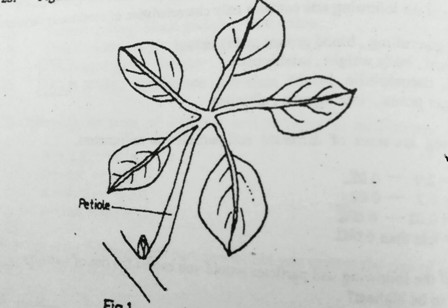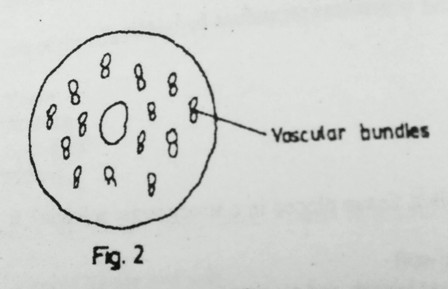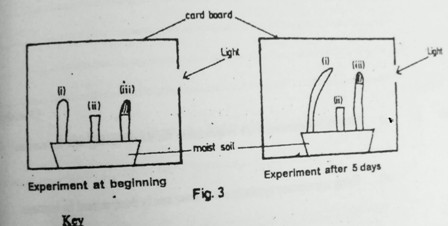PAPER 1
THEORY
SECTION A
Answer all questions in this section. For each question select the most correct option and write the letter representing it in the box provided.
1. Which of the following are characteristics of surfaces for gaseous exchange?
A. Large surface area, thinness and moistness.
B. Thinness, moistness and presence of fine blood vessels.
C. Large surface area thinness and presence of arteries and veins.
D. Thinness, moistness and presence of arteries and veins.
2. Stunted plant growth, creamy yellow leaves and poor fruit development is caused by deficiency of
A. Nitrogen and potassium.
B. Nitrogen and phosphorus.
C. Potassium and iron.
D. Nitrogen and iron.
3. Which one of the following dental formulate is that of a sheep?
A. I0/2 C0/0 Pm3/3 M3/3
B. I2/2 Pm2/2 M3/3
C. I3/3 C0/0 Pm 3/3 M2/2
D. I2/2 C1/1 Pm2/2 M3/3
4. Enzymes differ from catalysts because enzymes
A. Are required in small amounts.
B. Respond to temperature changes.
C. Are proteins in nature.
D. Speed up reactions.
5. When preparing to test for starch in a leaf, the leaf is boiled in alcohol in order to
A. Burst chloroplasts.
B. Remove coloured materials in the leaf.
C. Quicken the reaction of starch with iodine.
D. Soften the leaf.
6. In which of the following animals does expired route from that of inspired air?
A. Birds.
B. Reptiles.
C. Bony fish.
D. Mammals.
7. Which one of the following does not aid flight in birds?
A. Pectoral muscles.
B. Hollow bones.
C. Down feathers.
D. Quill feathers.
8. Which one of the following sets of organisms belong to the same group?
A. Butterfly, beetle and starfish.
B. Crab, tape worm and liver fluke.
C. Scorpion, mite and spider.
D. Jelly fish, slug and sea urchin.
9. Which one of the following explains the accumulation of lactic acid in muscles during vigorous activity?
A. Carbohydrate is completely broken down.
B. The oxygen supply to the muscles may not be enough.
C. Much of the stored glycogen is converted into glucose.
D. The blood vessels leading from the muscles are constricted.
10. Bacteria that often live in their hosts where both partners cannot survive without the other are called
A. Parasites.
B. Symbionts
C. Commensals.
D. Saprophytes.
11. In a plant tissue, water moved from cell A to cell B. this indicates that
A. Cell A and cell B had the same osmotic potential.
B. Cell A had a higher osmotic potential than cell B.
C. Cell A had a lower osmotic potential than cell B.
D. Cell A was older than cell B.
12. Which of the following are the end products of lactose?
A. Glucose and sucrose.
B. Glucose and Galactose.
C. Glucose and fructose.
D. Fructose and Galactose.
17. Which one of the following sets contains only characteristics of continuous variation?
A. Tongue rolling, blood groups, skin color.
B. Height, body weight, intelligence.
C. Sex, hemophilia, height.
D. Finger prints, intelligence, albinism.
18. The following are sizes of different soil particles in millimeters.
P = 2.0 - 0.02.
Q = 0.2 - 0.02.
R = 0.02 - 0.002.
S = less than 0.002.
In which of the following soil particles would you expect the rise of water by capillarity to be highest?
A. P
B. Q
C. R
D. S
19. Which one of the following methods can be used to estimate the population of butterflies in a flower garden?
A. Direct count.
B. Quadrant.
C. Line transects.
D. Capture release - recapture.
20. Where in the mammalian skin is the melanin pigment found?
A. Malphighian layer.
B. Granular layer.
C. Cornfield layer.
D. Subcutaneous layer.
21. Which one of the following organisms reproduce by budding?
A. Yeast
B. Amoeba
C. Spirogyra.
D. Mucor.
22. What would happen to a plant tissue placed in a strong sugar solution? It
A. Becomes longer and soft.
B. Maintains the original length and texture.
C. Becomes shorter and soft.
D. Becomes shorter and hard.
23. Figure 1 shows a leaf type

Which type of leaf is shown in the figure above?
A. Compound bipinnate.
B. Compound trifoliate.
C. Compound pinnate.
D. Compound palmate.
24. Which one of the following is not a function of blood?
A. Regulation of sugar level in the body.
B. Healing of damaged parts of the body.
C. Regulation of body temperature.
D. Transportation of wastes.
25. Figure 2 is a cross section of part of a plant.

From one of the following was the section obtained?
A. Root of dicotyledonous plant.
B. Stem of monocotyledonous plant.
C. Root of monocotyledonous plant.
D. Stem of dicotyledonous plant.
26. What effect does light have on the distribution of auxin at the tip of a plant shoot?
A. Causes equal distribution of auxin at the shoot tip.
B. Has no effect on the distribution of auxin at the shoot tip.
C. Concentrates more auxin on the dark side of the shoot tip.
D. Causes auxin to concentrate more on the illuminated side of the shoot tip.
27. Which one of the following is a modified root?
A. Irish potato tuber.
B. Cassava tuber.
C. Rhizome.
D. Corm.
28. Which one of the following organs is responsible for removing excess amino acids from blood?
A. Gall bladder.
B. Kidney.
C. Liver.
D. Spleen.
29. Which one of the following is the most common air pollutant?
A. Dust.
B. Fungicides.
C. Herbicides.
D. Smoke.
30. In which part of the kidney Nephron does reabsorption of glucose occur?
A. Proximal convoluted tubule.
B. Distal convoluted tubule.
C. Descending loop of Henley.
D. Ascending loop of Henley.
SECTION B
Answer all questions in this section. Answer must be written in the spaces provided.
31. a) What is an artery?
32. Figure 3 shows the effect of unidirectional light on the growth of plant shoots. Study the figure and answer and answer the questions that follow.

Key
(i) Intact coleoptiles,
(ii) Coleoptiles with cut tip.
(iii) Coleoptiles with tip covered with aluminum foil.
a) Explain why each coleoptile appears as shown after 5 days.
i) ..............................................................................................
ii) ..............................................................................................
iii) ..............................................................................................
b) What is the importance of the response shown in the diagram, to plants?
33. a) (i) which chromosomes are responsible for determining sex in humans?
(ii) Using appropriate symbols show how sex is determined in humans.
b) Red - green color blindness is a defect caused by a recessive gene carried on the X chromosome. What would be the phenotype of the offspring when a normal woman marries a color blind man? Show your working.
34. a) State four ways in which a leaf is suited for photosynthesis.
b) State two ways in which food transported to growing regions is utilized by the plant.
(i) .........................................................................................................................
(ii) ........................................................................................................................
SECTION C
Answer any two questions.
35. Using named examples, describe the methods of fruit and seed dispersal.
36. a) Give three characteristics of enzymes.
b) Describe an experiment to show that enzymes activity is affected by temperature.
37. a) Give effects of four air pollutants on living things.
b) Describe how human activities interfere with soil environment in Uganda.
38. Describe an experiment that you would carry out in the laboratory to test for the presence of a non - reducing (complex) sugar in a solution of a food sample. In your description, state the use of each reagent used.
